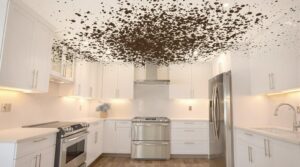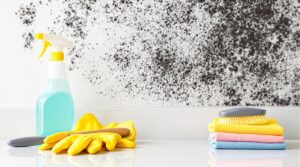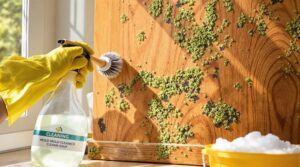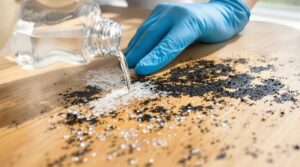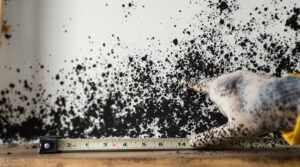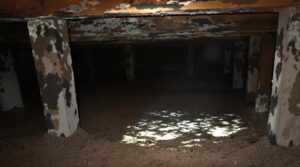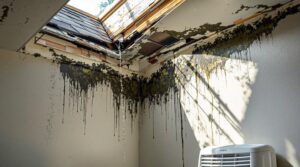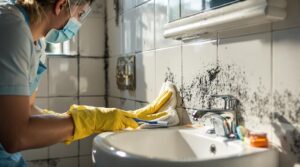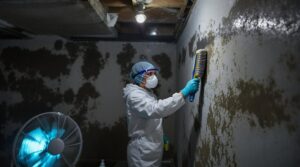Several proven substances effectively eliminate mold and mildew growth through chemical or natural intervention. Bleach solutions mixed at 1:1 ratios require 15 minutes of contact time, while white vinegar needs 60 minutes of exposure. Hydrogen peroxide demonstrates efficacy with 10-minute applications followed by mechanical removal. Baking soda paste provides additional abrasive cleaning action. Professional treatment options incorporate advanced techniques and specialized equipment for complete remediation of extensive contamination.
Key Takeaways
- Bleach solution mixed in a 1:1 ratio with water effectively kills mold and mildew after 15 minutes of contact time.
- White vinegar requires 60 minutes of exposure time to eliminate mold and mildew growth.
- Hydrogen peroxide kills mold and mildew when applied for 10 minutes before scrubbing the affected area.
- Baking soda paste provides mechanical cleaning action to remove mold and mildew from surfaces.
- HEPA vacuum cleaners capture loose mold spores and prevent them from spreading during cleanup.
Understanding the Difference Between Mold and Mildew
While mold and mildew are both common types of fungi that thrive in moist environments, they exhibit distinct physical characteristics and growth behaviors that aid in their identification.
The visible characteristics of mold include a fuzzy or grainy texture that appears raised from the surface, displaying colors ranging from black and grey to green, brown, and occasionally red.
In contrast, mildew presents as a flat, powdery growth that begins white and darkens to brown or black with age. Both fungi can be found in 90% of cases involving water damage.
Significant growth differences exist between these fungi. Mold penetrates deeply into organic materials like wood and drywall, developing extensive root systems that can cause structural damage. Quaternary ammonium compounds are highly effective at eliminating both surface and embedded mold growth.
Mildew remains superficial, establishing shallow roots on hard, nonporous surfaces, particularly in bathrooms and other moisture-prone areas.
Mold spreads in large, spotty patches, while mildew forms distinctive clusters of tiny dots, making accurate identification essential for determining appropriate treatment methods.
Natural Solutions for Mold and Mildew Removal
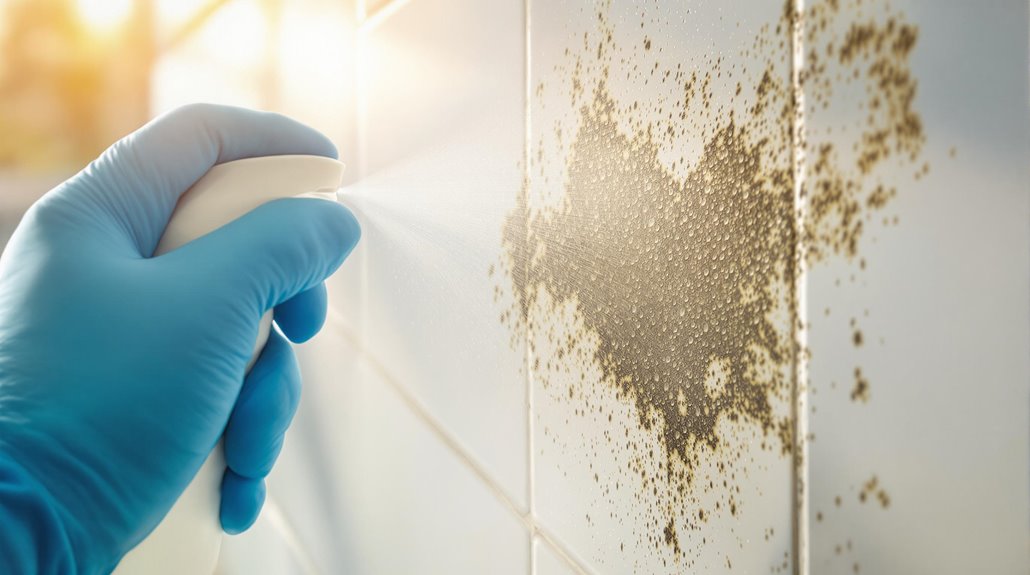
Natural alternatives to chemical cleaners provide effective solutions for eliminating mold and mildew while maintaining environmental safety. Several white vinegar sprays offer proven effectiveness in treating mold, with studies showing they can eliminate over 82% of mold spores. Using protective equipment like N-95 masks and gloves is essential when applying any mold treatment solution.
Chemical Products That Eliminate Mold Growth
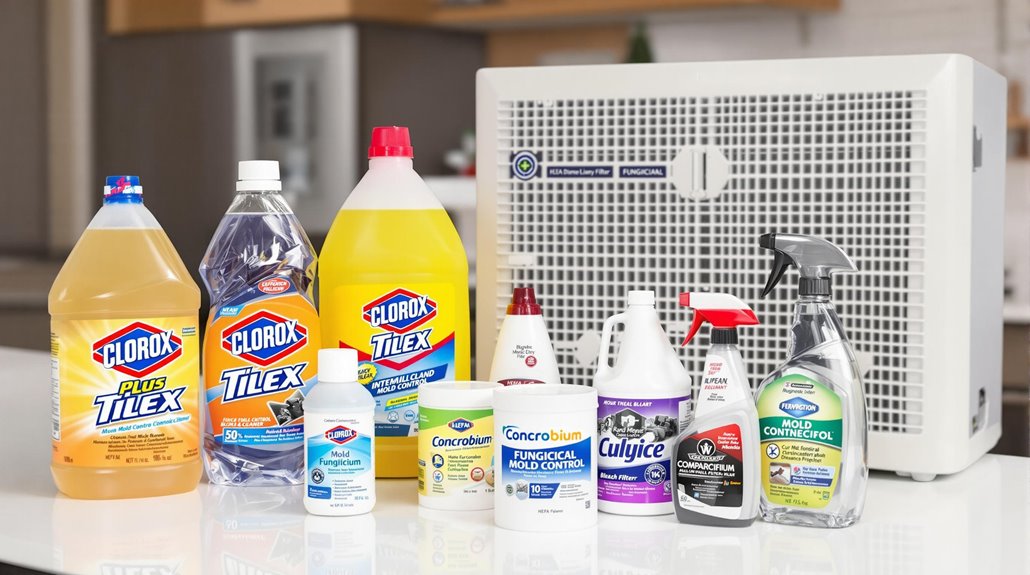
Chemical mold elimination products primarily utilize two approaches: bleach-based solutions and commercial fungicidal formulations.
Bleach-based cleaners like Clorox Plus Tilex and Zep effectively kill mold while removing stains through oxidation processes. HEPA air filtration should be maintained during treatment to capture airborne spores.
Commercial fungicidal products, such as Concrobium Mold Control and quaternary ammonium compounds, offer specialized formulations that both eliminate existing mold and create inhospitable conditions for future growth. For maximum safety and effectiveness, these products require proper ventilation during application.
Bleach-Based Cleaning Solutions
Among the most widely used chemical treatments for mold and mildew elimination, bleach-based cleaning solutions contain sodium hypochlorite as their active ingredient, which effectively denatures proteins and disrupts cellular components in mold spores.
When preparing bleach solutions, proper bleach ratios and mixing precautions are essential for maximum efficacy and safety.
Standard mixing guidelines include:
- 1/3 cup bleach per gallon of water for general cleaning
- 1 cup bleach per 3 gallons of water for larger applications
- Pre-wet surfaces before solution application
- Maintain surface wetness for 10 minutes
While effective on non-porous surfaces like tiles and sinks, bleach solutions have limitations on porous materials such as wood and drywall.
Safety measures require rubber gloves, eye protection, and adequate ventilation to prevent respiratory irritation during application.
For optimal effectiveness, treatment should begin within 48 hour window of water exposure to prevent extensive mold colonization.
Commercial Fungicidal Products
Three major categories of commercial fungicidal products dominate the market for professional mold elimination: quaternary ammonium compounds, hydrogen peroxide-based solutions, and proprietary antimicrobial formulations.
Products like BioCide 100 and Moldstat 2 demonstrate high fungicidal efficacy through quaternary ammonium compounds.
Essential Safety Measures During Mold Treatment
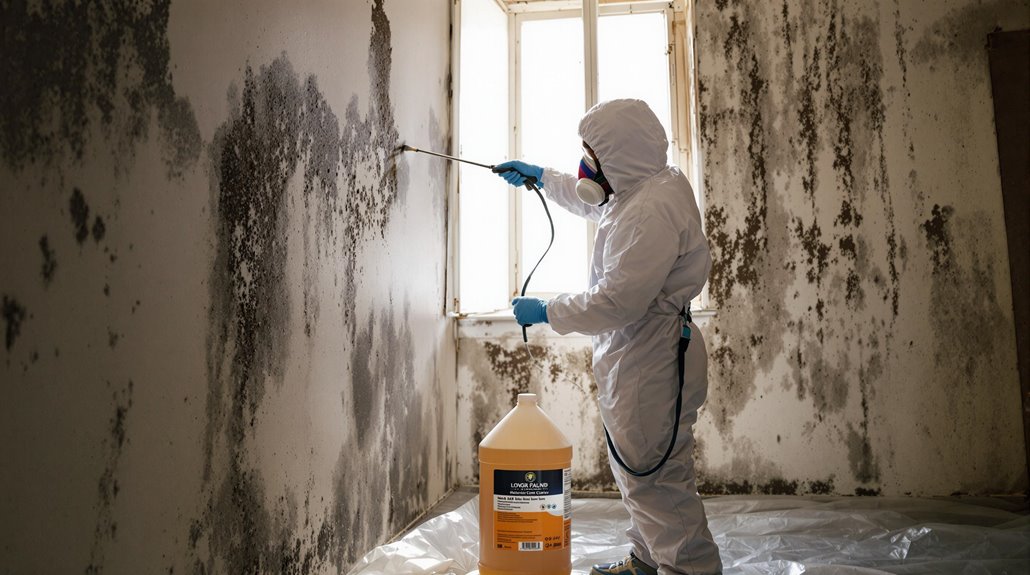
Proper safety equipment represents a critical requirement during mold remediation, including N95 respirators, protective gloves, eye protection, and full-body coveralls to prevent exposure to harmful spores.
The safe handling of cleaning chemicals demands adherence to manufacturer guidelines regarding dilution ratios, application methods, and ventilation requirements.
Professional-grade protective measures must extend to establishing containment zones and decontamination procedures to prevent cross-contamination between treated and untreated areas.
Mold spore counts can increase by 10 to 1000 times during active removal, making proper protective equipment essential for worker safety.
Protective Equipment Requirements
Safe mold remediation requires specific protective equipment to shield workers from harmful spores and mycotoxins during cleanup operations.
Proper respiratory protection includes N-95 respirators or half-face elastomeric respirators fitted with P-100 filters, providing 99.97% protection from
Professional mold inspectors must maintain proper certification and state licensing while following strict ASTM and IAC2 guidelines for testing and remediation.
Safe Chemical Handling
Effectively handling chemicals during mold remediation requires strict adherence to established safety protocols and protective measures. Professionals emphasize using mild detergents and avoiding bleach-based solutions due to potential health risks. Proper chemical dilution ratios and protective gloves are essential when applying cleaning agents.
| Safety Measure | Implementation |
|---|---|
| Ventilation | Maintain airflow during chemical application |
| Chemical Storage | Keep solutions separate to prevent toxic reactions |
| Application Method | Use HEPA vacuums and misting for dust control |
Alternative cleaning solutions, such as hydrogen peroxide and vinegar, offer safer options for mold treatment. Professional oversight guarantees correct handling procedures while preventing cross-contamination through proper isolation techniques. The use of dust suppression methods and sealed containment areas substantially reduces the risk of spore dispersal during remediation processes. Environmental assessments required help determine the scope and safety measures needed for effective mold remediation.
Prevention Strategies for Long-Term Protection
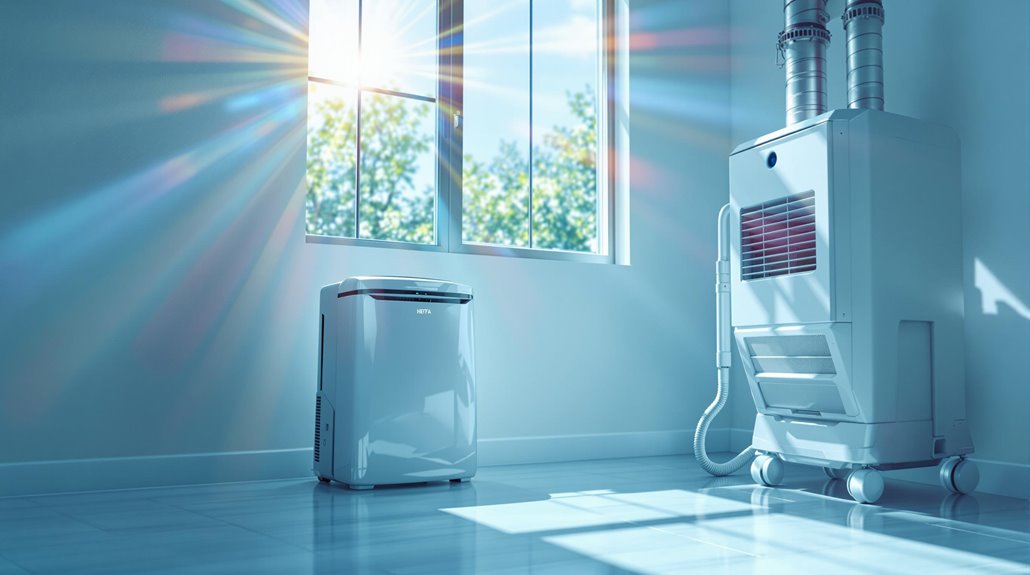
Implementing exhaustive prevention strategies against mold and mildew requires a multi-faceted approach focused on moisture control, ventilation, and environmental management.
Effective drainage solutions include installing sump pumps, maintaining proper ground slopes away from foundations, and implementing complete drainage systems.
Ventilation strategies encompass the installation of attic fans, HVAC maintenance, and strategic placement of dehumidifiers.
Key preventive measures include:
- Maintaining indoor humidity levels below 60% through active monitoring
- Installing mold-resistant building materials during renovations
- Implementing HEPA filtration systems to reduce airborne spores
- Establishing regular maintenance schedules for HVAC and drainage systems
Long-term protection requires vigilant moisture detection and rapid response to water intrusion events within 24-48 hours.
Spore growth conditions typically include temperatures between 77-86°F and humidity levels above 70%, making climate control essential.
Professional HVAC inspections twice yearly, combined with proper air circulation management and strategic placement of ventilation equipment, create an environment inherently resistant to mold and mildew development.
When to Call Professional Mold Remediation Services
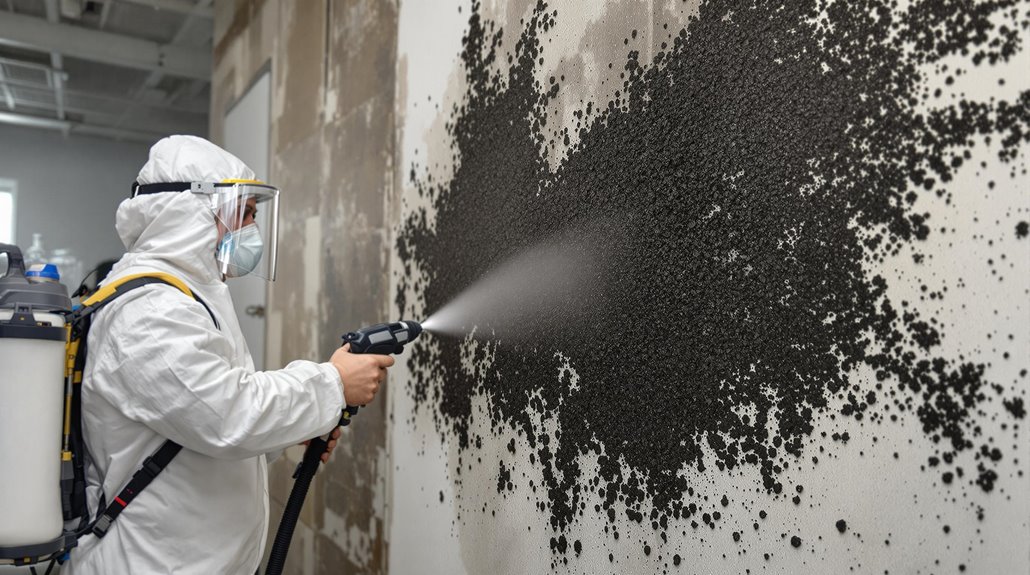
While prevention strategies can mitigate many mold issues, certain situations demand professional intervention for effective remediation. When mold infestation exceeds 10 square feet or spreads to multiple areas, professional services become essential. Areas larger than 100 square feet require full containment protocols and specialized equipment for safe removal.
Professional remediation becomes critical when occupants experience health complications from mold exposure, particularly those with existing respiratory conditions or compromised immune systems.
DIY attempts often prove inadequate, potentially dispersing spores and exacerbating the problem. Trained specialists conduct thorough moisture assessments to identify the root cause and implement complete solutions.
Professional remediators possess the expertise and equipment necessary for proper containment, removal, and disposal of contaminated materials. They employ advanced techniques to prevent cross-contamination and guarantee complete elimination of mold colonies, especially in cases involving hidden growth or extensive water damage.
Early detection is crucial since mold typically develops within 24-48 hours after water exposure in affected buildings.
Best Cleaning Methods for Different Surfaces

Different surface types require specific cleaning approaches to effectively eliminate mold and mildew growth.
Surface treatments vary substantially between porous and non-porous materials, with each requiring distinct cleaning techniques for ideal results.
For hard, non-porous surfaces, several effective treatment options exist:
- Bleach solution (1:1 ratio with water) requires 15 minutes of contact time
- Undiluted white vinegar needs 60 minutes of surface exposure
- Hydrogen peroxide treatment demands 10 minutes before scrubbing
- Baking soda paste provides mechanical and chemical cleaning action
Porous materials present greater challenges in mold remediation, often requiring replacement rather than cleaning.
Materials such as ceiling tiles, carpet, and upholstery frequently cannot be adequately cleaned due to mold penetrating deep within their structure.
Professional intervention becomes necessary when dealing with extensive mold infiltration in porous surfaces, as specialized equipment and expertise are required for thorough remediation.
Using HEPA vacuums during cleaning helps capture loose spores an
The Benefits Of Consulting A Public Adjuster
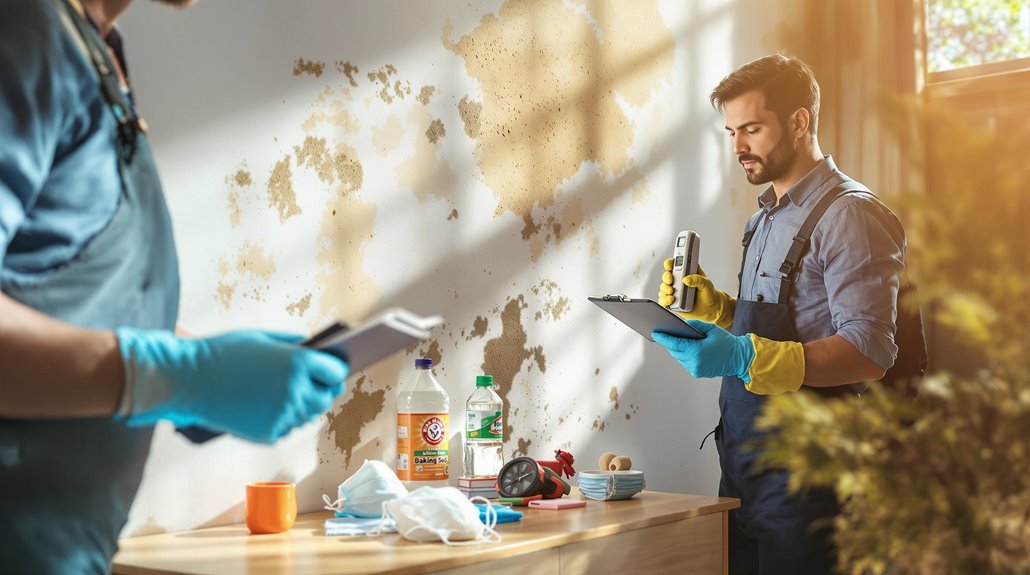
When dealing with extensive mold and water damage, a public adjuster's expertise in insurance claims and objective damage assessment can be invaluable for securing proper compensation.
These licensed professionals streamline the claims process by thoroughly documenting damage, analyzing policy coverage, and managing all communications with insurance carriers.
Research indicates that claims handled by public adjusters often result in substantially higher settlements due to their specialized knowledge and negotiation skills.
Expertise In Insurance Claims
Insurance specialists known as public adjusters serve as invaluable advocates for policyholders handling complex property damage claims. Their claims expertise and insurance knowledge enable thorough policy interpretation and exhaustive documentation of losses.
- Deep understanding of insurance procedures and requirements guarantees maximum claim settlement potential
- Professional management of paperwork, inventories, and proof of loss documentation maintains compliance
- Strategic negotiation techniques counteract insurance company tactics to minimize settlements
- Expertise in policy interpretation identifies often-overlooked coverage benefits
Public adjusters streamline the claims process through systematic documentation and skilled negotiation.
Their professional oversight reduces policyholder stress while maximizing claim settlements through detailed damage assessment, thorough evidence compilation, and persistent advocacy. This expertise proves particularly valuable in complex scenarios involving extensive property damage and substantial loss claims.
Objective Damage Assessment
Professional damage assessment represents a critical component in the accurate evaluation of mold-related property claims. Public adjusters conduct exhaustive inspections that include moisture mapping and structural assessment to document the full extent of contamination. This systematic approach guarantees no affected areas are overlooked during the claims process.
The assessment protocol involves detailed documentation of visible mold growth, underlying damage patterns, and potential hidden impacts within building materials.
Adjusters gather photographic evidence, prepare thorough inventories of affected belongings, and develop precise repair estimates based on current market rates. This objective evaluation serves as the foundation for policy interpretation and subsequent negotiations with insurance carriers, helping to establish the true scope of damages and necessary remediation measures.
Streamlined Claim Process
Following a thorough damage assessment, engaging a public adjuster can substantially optimize the claims process for mold-related incidents.
The implementation of claims automation and paperwork simplification markedly reduces processing time while maintaining accuracy in documentation.
Public adjusters facilitate this streamlined approach through:
- Automated workflow implementation for systematic document processing and tracking
- Expedited settlement negotiations through professional representation
- Strategic coordination with insurance providers to guarantee policy compliance
- Implementation of digital documentation systems for real-time claim status updates
This methodical approach results in accelerated claim resolution while maintaining procedural integrity.
The integration of automated systems with professional oversight guarantees all necessary documentation is properly processed, policy requirements are met, and communication channels remain clear throughout the settlement process. This systematic methodology markedly reduces processing delays while maximizing claim accuracy.
Higher Claim Payouts & Settlements
Securing maximum compensation for mold-related claims consistently demonstrates higher success rates when enlisting public adjuster services. Statistical evidence reveals that homeowners utilizing public adjusters receive increased payouts averaging $22,266, compared to $18,659 for those who process claims independently.
Settlement optimization occurs through multiple mechanisms: thorough damage assessments, expert policy interpretation, and professional negotiation strategies.
Public adjusters operate on a percentage-based fee structure, typically ranging from 5% to 20%, with state-specific caps ensuring fair compensation practices. This financial model aligns the adjuster's interests with policyholder outcomes, incentivizing maximum claim recovery. Their expertise in evidence documentation, coupled with thorough understanding of insurance policies, systematically yields superior settlement results, making their services particularly valuable for complex mold-related claims.
About The Public Claims Adjusters Network (PCAN)
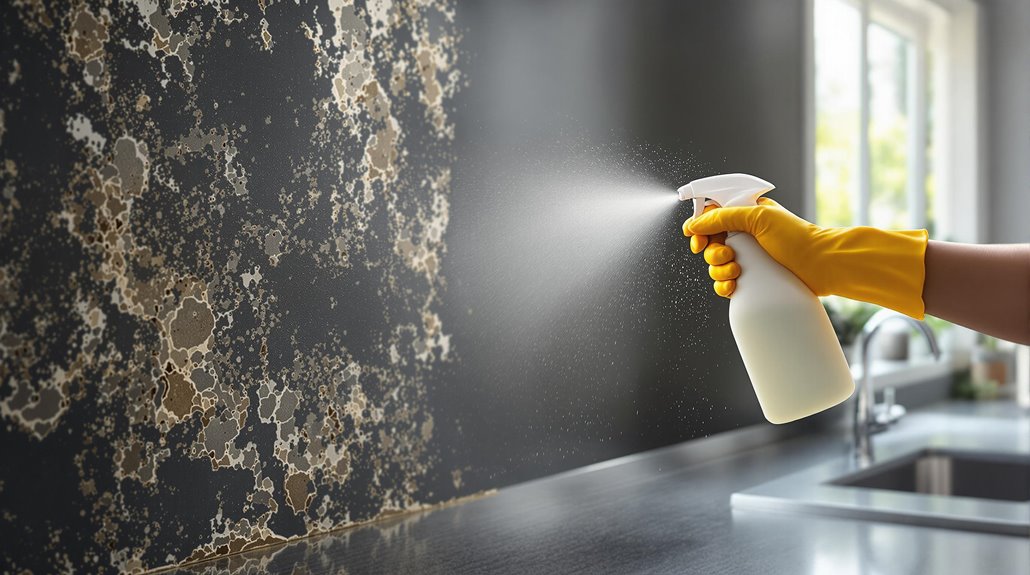
Claims adjuster networks form essential infrastructures in the insurance industry, with the Public Claims Adjusters Network (PCAN) standing as a prominent organization that connects licensed public adjusters across multiple jurisdictions.
Through systematic claims analysis and network collaboration, these organizations leverage decades of expertise to optimize insurance claim outcomes.
Professional adjuster networks provide complete service solutions throughout the claims lifecycle, incorporating:
- Daily and catastrophic (CAT) claims management capabilities
- Immediate response protocols through dedicated call center support
- Customized operational solutions based on specific claim requirements
- Quality assurance measures ensuring consistent service delivery
The network structure enables efficient deployment of experienced adjusters while maintaining high service standards across various claim types.
This systematic approach facilitates thorough documentation, accurate assessment, and expedited resolution of claims, ultimately benefiting both insurers and policyholders through streamlined processes and professional expertise.
Frequently Asked Questions
Can Dead Mold Spores Still Cause Health Problems if Not Removed?
Dead mold spores retain their allergenic properties and can cause significant health impacts, including respiratory effects, allergic reactions, and inflammation. Their mycotoxins remain active, necessitating complete removal for occupant safety.
How Soon After Water Damage Should Mold Treatment Begin?
Mold treatment requires immediate response within the first 24-48 hours after water damage occurs. Professional moisture monitoring and remediation must begin promptly to prevent spore colonization and minimize structural deterioration.
Does Painting Over Mold Permanently Solve the Problem?
While paint limits visibility of mold, it fails to address the underlying problem. Without proper surface preparation and moisture remediation, mold continues growing beneath paint, potentially causing health hazards and structural damage.
Can Air Purifiers Effectively Remove Mold Spores From Indoor Spaces?
Air purifiers equipped with HEPA filtration effectively capture airborne mold spores through continuous recirculation patterns. Regular filter maintenance guarantees peak performance, though they cannot eliminate existing mold growth on surfaces.
Should I Test for Hidden Mold if I Can Smell It?
Like a canary in a coal mine, musty odors signal mold's presence. Professional inspection is recommended over testing since test accuracy varies, and visible or olfactory evidence already confirms contamination.
References
- https://www.epa.gov/mold/what-are-basic-mold-cleanup-steps
- https://www.bobvila.com/articles/what-kills-mold/
- https://www.epa.gov/mold/mold-cleanup-your-home
- https://www.homedepot.com/c/ah/how-to-get-rid-of-mold/9ba683603be9fa5395fab907c52351c
- https://prohousekeepers.com/blog/ultimate-mold-cleaning-guide/
- https://www.cleanerguys.com/mold-vs-mildew/
- https://www.homesandgardens.com/solved/mold-vs-mildew
- https://rainbowrestores.com/blog/mold/mildew-vs-mold
- https://www.familyhandyman.com/article/difference-between-mold-and-mildew/
- https://www.thepioneerwoman.com/home-lifestyle/a60686967/mildew-vs-mold/
